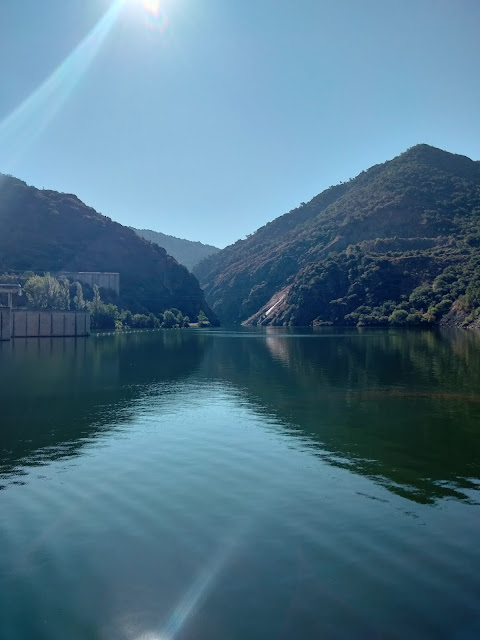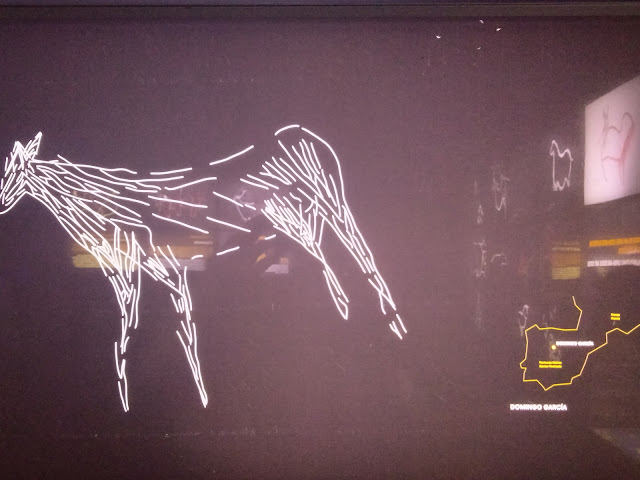Wednesday, August 16, 2023
Today's activity plan was a bit out of the norm. They put everyone into one of two groups. In the afternoon, Group 1 would be doing Activity 1, while at the same time Group 2 would be doing activity 2. Then, on Thursday morning, Group 1 would do Activity 2 at the same time Group 2 was doing Activity 1.
But first, we left the dock at Pinhao and continued eastward. This was the longest leg of the voyage; 4 hours.
The weather was perfect again...sunny, warm, and clear. And the views continued to be spectacular.
At times the terrain changed from lush gentle terraced vineyards to rough sheer rocks. And the river narrowed in places so much that it was only wide enough for one boat (like ours) to pass through at a time (the companies have to plan who will be where at what time). The Portuguese word for "hard" is duro. Many people believe that this is how the Douro River got its name...because it is so hard to navigate. It was much worse in centuries past as there were steep waterfalls in some spots. But those have all been eliminated by the locks and the dams. There are 15 in all: 5 on the Spanish side, 5 along the border, and 5 in Portugal. Fun Fact: at 754 miles, this is the longest border in the EU!
After about 90 minutes, we reached the first of two locks we had to pass through today; the Valeira Lock.
This time, not only is there a bridge across the top, but the water level on the other side was higher than normal. So everyone was ordered completely off the sundeck. Once we were though the lock, we had to stay on the main deck because up ahead was a railroad bridge that spanned the river. Due to the river's height, our ship's clearance would be minimal. Meanwhile....more outstanding views:
 |
This is a memorial to people who died on the river in the 1800s. Some of
the names are on plaques; others are carved right into the stone.
We are now in the Douro Superior region...the eastern part of the river. And here comes that railroad bridge.
|
You can see the bottom of the bridge right above us!
Finally we were allowed back up top, where we took in the sun and scenery for another hour or so. Then we got to the
Pocinho Lock. No drama here. We got through and went a couple hundred yards farther to our dock for the rest of the day.
So....the two activities:
1. A 45 minute drive to a vineyard and then transfer to a Jeep to drive through it
2. A 20 minute drive to a museum dedicated to the Coa Valley rock carvings.
We were in group 2.
We had no idea that there were thousands of rock carvings in Portugal. The Coa Valley (formed by the Coa River, a tributary of the Douro) is home to many of these. The
Coa Museum tells the story of the history of these 20,000 year old (Paleolithic Era) carvings, the people who made them, and the efforts to save them.
Many of the actual carvings are located near the river (no surprise), but the area is very hard to get to (not even an option on this tour), so the museum features replicas of them, plus other supporting material and visuals. Here, for example, is a map showing different types of carvings and paintings from this period all around the world.
The docent told us that, while the people who "populated" these areas (they were really mostly nomadic) hunted and ate all kinds of animals (including rabbits and squirrels), the etchings almost exclusively feature only 4 types of larger animals: deer, horses, ibexes, and
aurochs. Archaeologists believe that this is because the larger animals provided more than just meat - hides for clothing and to make shelters, bones for tools, etc. And carvings of humans are exceedingly rare; the theory here is that man saw himself as a minor part of the big picture.
These two photos show similar carvings from different regions (zoom in to see small maps). This supports the idea of different nomad clans moving around and sharing ideas.
Many of the carvings were done on the schist which is so predominant in this area (see previous post). The schist is in layers (which helps determine the age of the carving), plus it fractures vertically along a smooth face. As seen above, when the rock is first scratched, the resulting lines are bright white. Thus they can be seen from some distance away. Perhaps they were used as signposts or to identify a particular clan. Over time, weathering makes the lines less visible. So it is not surprising that the same rocks were carved into repetitively. Here is a photo showing one such rock on which research has identified 86 separate unique animals carved over thousands of years.
Note that the colors shown here are only there for us to be able to discern the different animals. Archaeologists have found no evidence whatsoever that people in this region actually used any kind of paint on these carvings.
Not all of the etchings are so large or on rock faces. They have found many very small (some just 2" or so) stones with such carvings (though still with much detail!). Speculation is that these were carried or worn by people perhaps as we today might have a cross or a star or lucky charm with us. The more things change, the more they stay the same.
Thought to ponder: Even today, we still express ourselves in very visible ways. Does our modern-day graffiti have the same level of meaning to us as these pictographs did to our ancestors? Our docent maintained that this is truly what separates us from other animals: the different forms of art that we create.
So as you might expect, people did not stop scratching images, etc. into these rocks over the millennia. Indeed, the last known carving made before the area began to be seriously explored and protected was done on April 19, 1953.....two days before Wendy was born! It was done by the child of a man working in the area. He was actually interviewed in the 90s to tell what he knew of the area. Here is his contribution to this "gallery":
And what did he draw? The castle at Guimaraes that we just saw the other day!!!!!!!!
How nice of him to include his name and the date. Too bad our ancestors did not do likewise ("Thag drew this 1002 BC").
The museum building itself is worthy of mention. When you are in the parking lot, the roof of the building is at ground level! You actually walk down into a narrowing darkening V-shaped corridor...as if you were going back in time and walking into a cave. And the rooms inside are lit at a very low level and feature black walls...also to help you feel that experience.
Then back to the boat.
Tonight featured the Chef's Signature Dinner. Everyone went to the dining room at the same time and were served the same 5 course meal (though we did have a choice of entrees).
 |
| The napkins! |
First up was smoked "barbarie" duck breast with cucumber, thyme, orange wedges and asparagus tips. When they served them, they lifted the glass domes and smoke poured out. But it must have been dry ice as the food was chilled, not hot!
 |
The actual duck breast was about the size of a half dollar,
wafer thin, and is at the bottom of the pile |
Pretty tasty, though Wayne did not eat the cukes, oranges, or asparagus!
Next up: silky cauliflower cheddar soup:
Silky and good, but a little too cheesy for Wendy (Wayne skipped this course).
Third was the warm appetizer: seared "secrettos pata negra", which turned out to be small strips of pork, rucola (arugula), cherry tomatoes, shaved Parmagian, and celeriac puree.
This was reallllly good, though Wendy did not eat the pork (between the two of us, we are getting one full meal!).
Then the mains. Wayne had the Land & Sea Duet: sauteed shrimps, beef tenderloin, wild broccoli, baby carrots, and cauliflower mashed potatoes.
One of the best dishes of the whole trip!
Wendy opted for the grilled Peixe Espadarte.....swordfish with lemon citronette, shitake mushrooms, Parisienne carrots, beet coulis, and Maxim potatoes.
This too was outstanding.
Finally....dessert: bourbon vanilla white Port wine creme brulee....served flaming!
WHOA!!!!! Impressive and deeeeelicious!
Finally a plate of petit fours.
All in all a great day.
Love w&w..............
Note: Spain is 1 hour ahead of Portugal (thus 7 hours ahead of US Central time). By the time you are reading this, we'll be in that zone.

























No comments:
Post a Comment